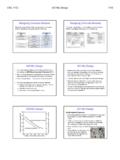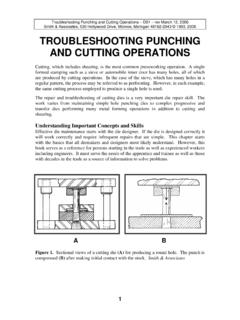Transcription of ACCEPTANCE OF CONCRETE COMPRESSIVE …
1 1 ACCEPTANCE OF CONCRETE COMPRESSIVE STRENGTHProf. Tibor Kausay Dr. Tam s K. SimonThe new CONCRETE standards give directives regarding the checking if the hardened concreteconforms to the COMPRESSIVE strength requirements of the designed COMPRESSIVE strengthclass. The ACCEPTANCE or rejection of conformity is the function of the COMPRESSIVE strengthtesting methods and the evaluation of the test results. In the paper through examples we showthe role of the ACCEPTANCE probability and the ACCEPTANCE constant during the evaluation oftest results and their significance during the conformity verification : CONCRETE , CONCRETE grade, conformity, continuous manufacturing, continuoustesting, identification testing, ACCEPTANCE probability, ACCEPTANCE constant, design value1.
2 INTRODUCTIONA ccording to table of MSZ EN 1992-1-1:2005 (Eurocode 2) standard, during the designof CONCRETE structures the mean COMPRESSIVE strength valuefcm,cyl is derived from thecharacteristic COMPRESSIVE strength valuefck,cyl by using the following relationship:fcm,cyl=fck,cyl+ 8 [N/mm2](1)This relationship is valid for cylindrical samples of 150 mm diameter, 300 mm high, 28days of age and cured under water throughout the time (wet cured). Generally the concretetechnology tests the conformity of COMPRESSIVE strength on cubes with the sizes of 150 mm, atthe age of 28 days which were mix cured (first 7 days under water, 21 days on air).
3 If we accept that according to the new CONCRETE standard, namely MSZ EN 206-1:2002 European standard and it s roles of application in Hungary MSZ 4798-1:2004 document, untilthe COMPRESSIVE strength class C50/60:fc,cube/fc,cyl = is the ratio between the wet cured, cylindrical samples of 150mm diameter, 300 mm high and cubic samples with the sizes of 150 mm,andfc,cube/fc,cube,H = is the ratio of the COMPRESSIVE strengths of the wet cured and mixcured normal CONCRETE cubic samples with the sizes of 150 mm,then the connection between the COMPRESSIVE strengths of the mix cured cubic samples withthe sizes of 150 mm (fc,cube,H) and the wet cured cylindrical samples of 150 mm diameter, 300mm high (fc,cyl)
4 Can be expressed asfc,cube,H = ( ) fc,cyl ~ fc,cyl,(2)which after substituting into the right and left side of relationship (1) will derive tofcm,cube, ,cube, + 8 [N/mm2], and from here we can arrive to the2fcm,cube,H=fck,cube,H+ [N/mm2]expression. This gives the relation of the mean COMPRESSIVE strength and characteristiccompressive strength of the 28 days old sample cubes with edges of 150 mm, mix cured,according to MSZ EN 1992-1-1:2005 until the COMPRESSIVE strength class of C50 by the approach of MSZ EN 1992-1-1:2005 for example the CONCRETE of C25/30compressive strength class at the age of 28 days, mix cured, should have a minimum meancompressive strength determined using cubes with 150 mm edges offcm,cube,test,H fcm,cube,H= 33 + = [N/mm2].
5 Based on the MSZ EN 206-1:2002, and the MSZ 4798-1:2004 Hungarian standards theconcrete having the COMPRESSIVE strength class of C25/30 at the age of 28 days, mix cured andthe COMPRESSIVE strength is determined on cubes with the sizes of 150 mm will have a meancompressive strength instead of the above calculatedfcm,cube,H= N/mm2 onlyfcm,cube,H =fck,cube,H + min = 33 + 3 = N/mm2. A certain safety margin is givenby that between the design COMPRESSIVE strength value of CONCRETE (fcd) and the characteristicvalue of it defined on standard cylindrical samples with 150 mm diameter, 300 mm height andwet cured (fck,cyl) exists the relation offcd =fck,cyl cc/ c, where c = is the safety factor ofconcrete COMPRESSIVE strength in the ultimate limit state and cc = is the decrease factortaking into consideration the long term load bearing capacity.
6 Accordingly for example thedesign COMPRESSIVE strength of a CONCRETE (fcd) defined on standard cylinders which were wetcured isfcd = it is found during the statical calculation not taking into consideration theenvironmental conditions that the practice would require a CONCRETE havingfcd = N/mm2 design value, then the designer based on MSZ EN 1992-1-1:2005 willprescribe CONCRETE of C25/30 COMPRESSIVE strength class. To this class, according to the abovefcm,cube,H= N/mm2 mean COMPRESSIVE strength belongs, considering mix cured standardcubes.
7 At the same time the mixing plant will satisfy the prescription based on MSZ 4798-1:2004 with a CONCRETE having a mean COMPRESSIVE strength offcm,cube,H = N/mm2considering also mix cured standard deviation arises from the different relationship calculation of the characteristic andmean values, which is being further complicated by the unusualness of the acceptanceconstant ( n) given in the new CONCRETE the hardened CONCRETE is to be characterized by it s COMPRESSIVE strength andbody density, in special cases by frost resistance, corrosion resistance, water permeability,resistance against wear etc.
8 , and according to these properties, based on MSZ EN 206-1:2002,and the MSZ 4798-1:2004 Hungarian standards should be classified. The paragraph ofMSZ 4798-1:2004 Hungarian standard deals with the classification of hardened CONCRETE , thetesting and requirements are given in paragraph , the conditions of conformity and thecontrolling procedures are dealt with in the 8. CONCRETE satisfies the COMPRESSIVE strength requirements if it complies to and appendix A and B of MSZ 4798-1:2004 Hungarian standard regarding thecompressive strength and the body COMPRESSIVE strength testing and evaluation of the test result differentiation mustbe made between the discrete CONCRETE constitutions sampling and testing procedure, while inthe conformity conditions between initial production and testing, the continuous productionand testing and the identifying testing evaluation of the continuous production and identifying testing is to be done by themean value (fcm) and standard deviation (sn) of the test characteristic value (fck)
9 And so the derived COMPRESSIVE strength class is significantlyinfluenced by the ACCEPTANCE constant ( n):fck =fcm n sn(3)2. THE CONTINUOUS PRODUCTION AND TESTINGThe continuous production of CONCRETE starts at the time when at least 35 consequently underthe same conditions produced CONCRETE test results are available within the period of longerthan three month but not more than twelve month, and this is called by the new standards theinitial production. From the test results of the initial production the standard deviation must becalculated ( ), which gives a good approximation of the theoretical standard deviation andwhich under certain circumstances should be taken into consideration during the evaluation ofthe test results of the continuous production.
10 ()1112,212,- -=--= ==nfnfnff nitestcmcinitestcmci,wheren here on the smallest value of the standard deviation, in the case of wet curedstandard cylinders:- in case of normal CONCRETE (if the COMPRESSIVE strength class is C50/60): 3 N/mm2;- in case of high strength CONCRETE (if the COMPRESSIVE strength class is C55/67): 5N/mm2. The result of continuous production can be evaluated by at least 15 consequent samplingand testing within a maximum period of 12 month. The samples are to be taken continuouslyduring the production but not more frequently than one sample out of every 25 m3.









